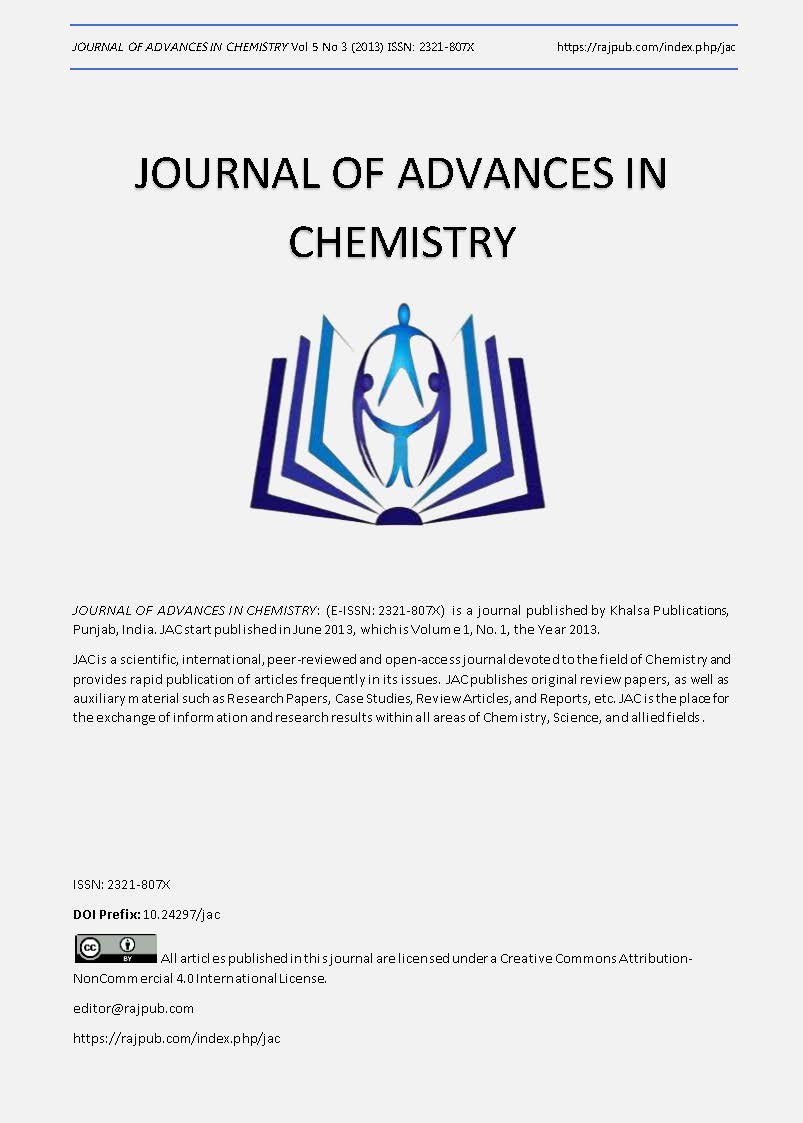Investigation of the Effect of Natural Extract on Corrosion Behavior of Tin in Na2CO3 Solution
DOI:
https://doi.org/10.24297/jac.v5i3.6593Keywords:
Electrochemical Impedance Spectroscopy, Potentiodynamic Polarization, corrosion inhibition, tin, Eugenol Oil, 0.1 M Na2CO3.Abstract
The inhibition effect of eugenol oil (EO) on the corrosion of tin in 0.1 M Na2CO3 has been studied by electrochemical impedance spectroscopy (EIS) and potentiodynamic polarization technics. The effect of temperature on the corrosion behavior of tin in 0.1 M Na2CO3 with and without addition of eugenol oil was studied in the temperature range 278-308 K. This compound inhibits the corrosion of tin at low concentration. At 4g/L eugenol oil the inhibition efficiency calculated by potentiodynamic polarization and EIS techniques is 70% and 82%, respectively. The inhibition efficiency increased with increase of the inhibitor concentration and decreased with increase of medium temperature. Electrochemical impedance spectroscopy was used to investigate the mechanism of corrosion inhibition. Polarization curves reveal that EO acts as a mixed-type inhibitor in corrosive solution. The results obtained from the different corrosion evaluation techniques are in good agreement.
Downloads
References
[2] E. Ait Addi, L. Bazzi, M. Elhilali, R. Salghi, B. Hammouti, M. Mihit, App. Surf. Sci. 253 (2006) 555–560.
[3] P.E. Alvarez, S.B. Ribota, M.E. Folquer, C.A. Gervasi, J.R. Vilche, Corros. Sci. 44 (2002) 49.
[4] S.A.M. Refaey, G. Schwitzgebel, App. Surf. Sci. 135 (1998)243–253.
[5] S.A.M. Refaey, Electrochim. Acta 41 (1996) 2545.
[6] J. DE Cuyper « Métallurgie et recyclage de l’étain » Techniques de l’Ingénieur, traité Matériaux métalliques
[7] X. Bill Huang, T. Pete, L. Ying-Sing, Electrochim. Acta 46 (2000) 671–679
[8] H. Ashassi-Sorkhab, D. Seifzadeh, Int. J. Electro- chem. Sci. 1 (2006) 92–98.
[9] A. A. Rahim, E. Rocca, J. Steinmetz, M. J. Kassim, R. Adnan, M. Sani Ibrahim, Corros. Sci. 49 (2007) 402–417.
[10] E. E. Oguzie, Mater. Chem. Phys. 99(2–3) (2006) 441–446.
[11] M. Pugh, L. M. Warner and D. R. Gabet, Corros. Sci. 7(1967)807-820.
[12] G. Bianchi, ChimicaInd. Milano, 29(1947) 295
[13] M. A. Arenas, A. conde, J. J. de damborenea, Corros. Sci. 44(2002) 511-520.
[14] S. N. Ebrahimi, J. Hadian, M. H. Mirjalili, A. Sonboli, M. Yousefzadi, Food Chem., 110(2008)927-931.
[15] H.H. Hassan, S.S. Abd El Rehim, N.F. Mohamed, Corros. Sci. 44 (2002) 37.
[16] M. S. Abd El Aal, A.H. Osman, Corros., NACE 36 (1981) 591.
[17] M. Drogowska, H. Menard, L . Brossard, J. Appl. Electochem. 2 1 (1991) 84.
[18] C. A. Gervasi, F. E. Varela, J. R. Vilche, P. E. Alvarez, Electrochim. Acta 42 (1997) 537.
[19] L. Brossard, M. Drogowska, H. Ménard,Trends. corros. Res.,(1993)209.
[20] S.S. Abd El Rehim, F. Taha, M.B. Saleh, S.A. Mohamed, Collect Czech. Chem. Commun. 58 (1993) 2013.
[21] M. Belkhaouda, L. Bazzi, R. Salghi, A. Benlhachemi, B. Hammouti, S. El Issami, M. Hilali, Phys. Chem. News 45
(2009) 137-141.
[22] S. S. Abdel Rehim, S.M. Sayyah, M.M. El Deeb. Mater. Chem. Phys., 80 (2003) 696.
[23] E. E. Foad El-Sherbini. Corros. Sci., 48 (2006) 1093.
[24] M. Pourbaix, Atlas d’équilibres Electrochimiques, Pergamon, Oxford (1966) 475.
[25] R. Schmid, American Journal of Botany, Vol. 59(4)(1972)423-436.
[26] L. A. Shelef, Journal Food Safety, 6(1983)29-44.
[27] C. G. Soto, Burhanuddin, Aquaculture, Vol. 136(1-2)(1995)149-152.
[28] P. Hernández Sánchez, S. López Miranda, C. Lucas Abellán, E. Núñez Delicado, Food and Nutrition Sciences,
3(2012)716-723.
[29]. H. A. Sorkhabi, B. Shaabani, D. Seifzadeh, Appl. Surf. Sci. 239 (2005) 154.
[30]. D. K. Yadav, B. Maiti, M. A. Quraishi, Corros. Sci. 52 (2010) 3586.
[31] A. Bouyanzer, B . Hammouti, L . Majidi, Mat. Letter. 60 (2006) 2840 – 2843.
[32] A. A. Khadom, A. S. Yaro, H. K. Abdul Amir, A. S. AlTaie, A. Y. Musa, Am. J. Appl. Sci. 6 (2009) 1403.
[33] F. Bentiss, M. Bouanis, B. Mernari, M. Traisnel, H. Vezin, M. Lagrenee, Appl. Surf. Sci. 253 (2007) 3696.
[34] A. Popova, E. Sokolova, S. Raicheva, M. Christov, Corros. Sci. 45 (2003) 33–58.
[35] K. O. Orubite, N. C. Oforka, Mater. Letter. 58 (2004) 1768 – 1772.
Downloads
Published
How to Cite
Issue
Section
License
 All articles published in Journal of Advances in Linguistics are licensed under a Creative Commons Attribution 4.0 International License.
All articles published in Journal of Advances in Linguistics are licensed under a Creative Commons Attribution 4.0 International License.




